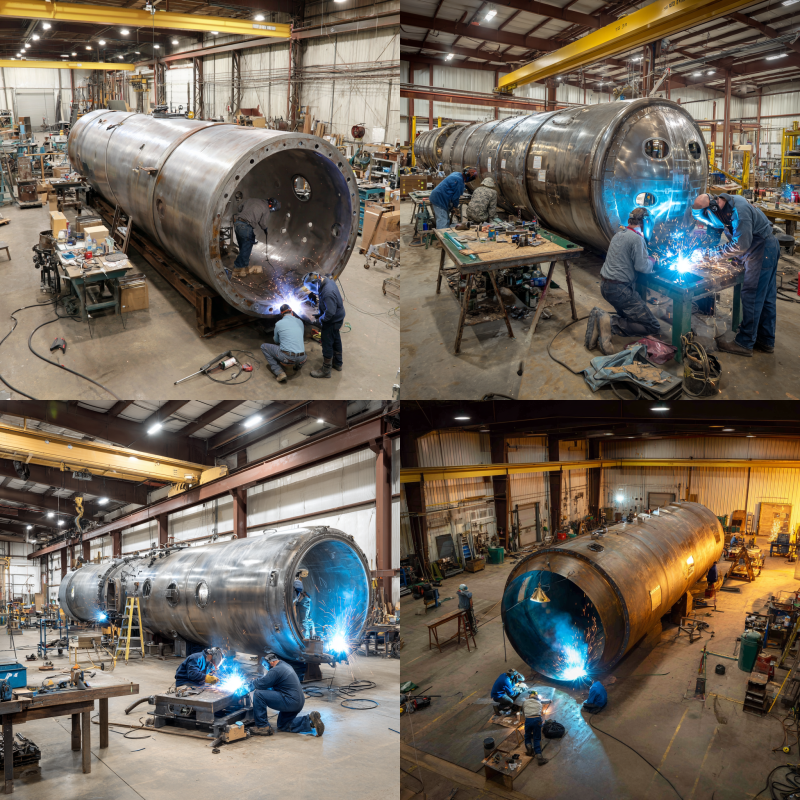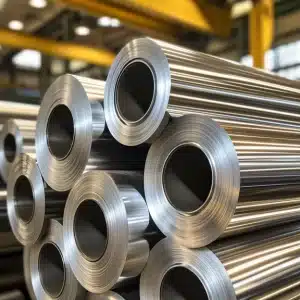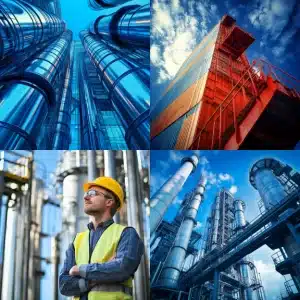
What You Should Know About Pressure Vessel Fabrication
Understanding Pressure Vessel Fabrication for Safe and Efficient Industrial Use
If you are researching pressure vessel fabrication for your industrial setup, you’re in the right place. Pressure vessel fabrication is the highly specialized process of designing and constructing containers capable of handling gases or liquids under pressure, often in extreme temperatures or corrosive conditions. Unlike simple storage tanks, vessels produced through pressure vessel fabrication are engineered systems built to perform reliably under demanding operating parameters without failure.
Today’s manufacturers, like Red River, rely on advanced pressure vessel fabrication techniques that combine decades of hands-on expertise with engineering software, automated welding systems, and precision inspection technology. This blend of craftsmanship and science ensures that every step of pressure vessel fabrication meets ASME standards and delivers safer, more efficient vessels for industrial use.
Pressure vessel fabrication plays a critical role across multiple industries. In the energy sector, it supports refineries, power plants, and renewable energy facilities. In chemical processing, it ensures volatile compounds are contained safely while enabling controlled reactions. In agriculture, pressure vessel fabrication enables the safe storage of fertilizers, crop treatments, and even biofuels.
By fully understanding each stage of the pressure vessel fabrication process — from design and material selection to testing, inspection, and certification — plant operators can ensure long-term reliability, workplace safety, and regulatory compliance. Investing in quality pressure vessel fabrication not only minimizes downtime and costly failures but also provides a strategic advantage in industries where efficiency, safety, and performance are non-negotiable.
Recognize pressure vessel fabrication
When you explore pressure vessel fabrication, you’re diving into the highly specialized process of designing and constructing containers engineered to withstand a wide range of internal or external pressure conditions. Pressure vessel fabrication ensures these vessels can store or transport gases and liquids safely, even in demanding industrial environments where failure is not an option. Because of the potential risks, every weld, joint, fitting, and structural component in pressure vessel fabrication must meet strict engineering standards and comply with industry regulations.
For those new to the subject, you can read more about “what is pressure vessel fabrication” to gain a broader understanding of how these systems are planned and built. The pressure vessel fabrication process involves multiple stages, including design calculations, material selection, cutting, forming, welding, heat treatment, inspection, and certification. Each stage of pressure vessel fabrication plays a critical role in ensuring the finished vessel is durable, reliable, and compliant with safety codes.
By learning how pressure vessel fabrication is carried out step by step, you begin to see why accurate design, the use of high-grade materials, and rigorous inspections are non-negotiable. Together, these elements make pressure vessel fabrication essential for protecting workers, extending equipment life, and guaranteeing structural integrity—ultimately ensuring vessels remain safe, efficient, and dependable throughout years of operation.
Identify core materials
Steel and its alloys often play starring roles in the fabrication of pressure vessels. Most manufacturers rely on carbon steel or stainless steel because of their ability to handle wide temperature ranges and resist harsh chemical conditions. Mild steel is common for standard pressure needs, while stainless steel is preferred for corrosive environments where durability is critical. Each choice carries unique benefits:
- Carbon steel: Resilient, cost-effective, and ideal for moderate pressures.
- Stainless steel: Corrosion-resistant and highly adaptable for acidic or high-moisture settings.
Beyond these primary materials, low-alloy steels are often selected when higher strength is required without significantly increasing vessel weight. For industries that face extreme operating conditions such as cryogenic storage, offshore drilling, or high-temperature reactors exotic alloys like Inconel, Hastelloy, or Monel provide superior resistance to both heat and aggressive chemicals.
In recent years, composite materials and clad steel have also gained traction in pressure vessel fabrication, particularly in applications where weight reduction or enhanced corrosion protection is essential. Cladding, for example, involves bonding a corrosion-resistant alloy layer onto a carbon steel base, delivering both cost efficiency and long-term durability.
Ultimately, material selection goes far beyond being a simple technical decision. It directly affects fabrication methods, inspection requirements, and long-term maintenance strategies. A trusted manufacturer evaluates pressure ratings, temperature variations, chemical compatibility, and budget constraints before recommending the best material blend for a project.
In certain cases, exotic alloys or advanced composites step in to ensure safe operation under extreme conditions. If you’d like a deeper look into these options, explore “what materials are used in pressure vessel fabrication”.
Explore prefabrication benefits
Prefabrication involves constructing large sections or complete modules in an off-site, controlled manufacturing facility before transporting them to the final installation site for assembly. This approach is rapidly gaining momentum in pressure vessel fabrication because it delivers clear advantages in efficiency, cost savings, and quality assurance. Red River emphasizes that prefabrication helps minimize project delays, provides greater schedule predictability, and creates more reliable outcomes compared to traditional on-site builds.
- Consistent environment: Indoor facilities shield operations from rain, wind, temperature swings, and other weather disruptions. Welders and technicians can work with precision and uniformity, which leads to stronger welds and more consistent results.
- Fewer errors in real time: Advanced tools like Computer-Aided Design (CAD) and Building Information Modeling (BIM) allow teams to identify design conflicts early. This proactive approach reduces rework, lowers expenses from on-site errors, and ensures smoother field assembly.
- Shorter timelines: Since prefabricated modules arrive at the job site nearly complete, less on-site labor is required. This accelerates installation, reduces field congestion, and speeds up project turnover, allowing facilities to go into operation sooner.
- Lower risk exposure: With fewer welding and fabrication hours required in the field, workplace hazards decrease significantly. Prefabrication improves compliance with safety standards and reduces liability while protecting workers.
Beyond these points, prefabrication promotes better weld quality, efficient material usage, and reduced waste generation. These efficiencies not only improve overall project economics but also support sustainable practices by minimizing scrap and energy consumption. Ultimately, prefabrication blends speed, safety, and sustainability, making it a powerful method for modern pressure vessel construction.
Understand main processes
Pressure vessel fabrication follows key steps: design, material preparation, welding, testing,and final inspection. Proper design starts with clarifying pressure demands, chemical handling requirements, and temperature ranges to ensure the vessel can safely handle its intended service. Engineers use advanced modeling software to predict performance and identify potential stress points before fabrication begins.
Once the design is finalized, the selected materials are prepared by cutting, shaping, and beveling to exact specifications. Skilled welders — often certified to ASME Section IX — then join the materials under strict quality guidelines, using methods such as TIG, MIG, or submerged arc welding. Throughout the process, many manufacturers maintain full material traceability, ensuring every plate, fitting, and weld can be tracked back to its source.
Testing may include non-destructive examination (NDE) such as ultrasonic or radiographic inspection, as well as hydrostatic pressure tests to verify performance under load. Whether using heat treatment to relieve stress or performing final inspections, the ultimate objective is the same: a safe, code-compliant vessel that will operate reliably for years to come.
Key Insights into Pressure Vessel Fabrication
Crafting a durable pressure vessel requires far more than simply welding steel plates together it demands strategic planning, advanced engineering, and a manufacturer deeply committed to compliance and safety. From initial material selection and detailed design to prefabrication, welding, and final testing, every stage of the pressure vessel fabrication process directly influences operational success.
One of the most important insights is that pressure vessel fabrication is never a one-size-fits-all process. Each vessel must be engineered to meet the precise requirements of its intended application, whether it’s handling superheated steam in a power plant, containing corrosive chemicals in a refinery, or storing agricultural products in a rural facility. This customization begins with a comprehensive needs assessment, followed by a design phase that incorporates structural calculations, safety margins, and strict adherence to industry codes such as ASME standards.
Material choice is equally critical in fabrication. The decision between carbon steel, stainless steel, or specialized alloys often determines whether a vessel delivers decades of reliable service or experiences premature failure. A reputable manufacturer will walk clients through the trade-offs in cost, durability, corrosion resistance, and performance, ensuring the final vessel is optimized for both safety and long-term economics.
Modern pressure vessel fabrication also benefits from advanced technologies. Automated welding systems improve consistency, precision plasma cutting ensures exact tolerances, and real-time quality monitoring minimizes defects before they become costly issues. Once fabrication is complete, rigorous testing—including non-destructive examinations and hydrostatic pressure trials—provides the final safeguard, confirming that the vessel can safely withstand its designed loads without compromise.
Ultimately, successful pressure vessel fabrication is best viewed as a collaborative partnership. By working with an experienced, certified fabricator, facility operators gain more than just a piece of industrial equipment they secure a long-term asset engineered for safety, efficiency, and reliable performance. This commitment to quality not only protects workers and operations but also reduces downtime, lowers maintenance costs, and ensures uninterrupted productivity for years to come.
Ready to Get Started with Expert Pressure Vessel Fabrication?
Don’t leave your project to chance. Whether you need custom-built ASME vessels, modular prefabricated units, or expert consulting, the right fabrication partner can save you time, reduce costs, and boost plant safety.
At Red River, we specialize in the design, fabrication, and manufacturing of high-quality pressure vessels, along with prefabricated spools and skid packages. Our American-made products are built with precision, integrity, and a commitment to your success.
Partner with Red River today and secure the quality, compliance, and reliability your facility deserves. Contact us now to get your project moving and experience the Red River difference.
Frequently asked questions
1. What is pressure vessel fabrication?
Pressure vessel fabrication is the process of designing, shaping, welding, and assembling materials into a vessel that can safely hold gases or liquids under pressure. It follows strict engineering standards such as ASME or API to ensure durability, performance, and safety. This process also considers long-term pressure vessel maintenance needs from the start.
2. How are pressure vessels fabricated?
Pressure vessels are fabricated by cutting and forming metal plates, welding them together, and performing non-destructive testing to check for flaws. Manufacturers follow detailed blueprints that account for operating pressure, temperature, and intended use. Quality checks are carried out at multiple stages to make future maintenance and inspections more efficient.
3. What materials are used in pressure vessel fabrication?
Common materials in pressure vessel fabrication include carbon steel, stainless steel, and specialty alloys like Inconel, Hastelloy, or Monel. The choice depends on the vessel’s operating environment, such as temperature, corrosion risk, and chemical exposure. Material selection also affects how often and what type of maintenance will be required.
4. What industries rely on pressure vessels?
Pressure vessels are essential in industries such as oil and gas, chemical and petrochemical manufacturing, power generation, food and beverage processing, and pharmaceuticals. Each sector has unique design codes, operating conditions, and maintenance schedules. To protect workers and assets, these industries invest heavily in regular inspections and strict compliance with safety standards.
5. Do I always need an ASME-certified vessel?
Not every application requires an ASME-certified vessel, but in many industries and jurisdictions, certification is either mandatory or strongly preferred. An ASME stamp guarantees that the vessel meets rigorous safety, design, fabrication, and testing standards. Choosing ASME-certified equipment often reduces liability and provides greater confidence in long-term performance.
6. How long does fabrication typically take?
Fabrication timelines depend on project scope, design complexity, material availability, and inspection requirements. Smaller vessels can sometimes be completed within weeks, while larger, custom-built units may take several months. Partnering with an experienced manufacturer helps streamline the process and minimize potential delays.
7. Why is prefabrication important?
Prefabrication is important in pressure vessel fabrication because it improves quality, reduces costs, and shortens project timelines. Building vessel components or modules in a controlled off-site environment ensures consistent welding conditions, minimizes weather-related delays, and allows for precise quality control.
8. How do I choose the right manufacturer?
Select a manufacturer with recognized industry certifications, such as ASME, to ensure compliance with strict safety and quality standards. Look for proven experience in building vessels similar to your needs and request references or case studies. Evaluate their engineering and design capabilities, quality control processes, and in-house testing methods like non-destructive examination (NDE) and hydrostatic testing. A reliable manufacturer will also demonstrate strong project management skills, transparent communication, and a commitment to meeting timelines without compromising safety or performance.
Key takeaway
- Choose a reputable manufacturer with proven experience in pressure vessel fabrication to guarantee safety, code compliance, and long-term reliability.
- Match vessel materials carefully to your specific process demands, considering factors like pressure, temperature, and chemical compatibility.
- Leverage prefabrication methods to reduce on-site labor costs, minimize safety risks, and keep projects on schedule.
- Schedule regular inspections and maintenance to detect potential issues early and maintain compliance with industry standards.
- Emphasize quality at every stage—from design, engineering, and welding to final testing—to ensure dependable, long-lasting performance.
- Plan corrosion protection strategies early, including coatings, linings, or cathodic protection, to significantly extend service life and reduce costly repairs.
Related Blog Post

Marine-Grade vs Standard Stainless Steel

Pros and Cons of Vertical Integration

How to Dry Desiccant Properly and Regain Its Effectiveness

Why Do Gas Turbines Need Fuel Water Separator Vessels, Red River

